Integrated Methodological Approach for the Documentation of Marine Priority Habitats and Submerged Antiquities: Examples from the Saronic Gulf, Greece
Abstract
1. Introduction
2. Study Area
3. Data and Methodological Approach
3.1. First Level of Information: Desk-Based Survey
3.2. Second Level of Information: Remote Sensing Survey
- Research vessel and Navigation
- Seafloor marine geophysical survey
- Substrate marine geophysical survey
- Seabed Classification
3.3. Third Level of Information: In-depth Inspection and 3D Mapping
4. Results and Analysis
4.1. Implementation of the First Level: Desk-Based Survey
4.2. Implementation of the Second Level: Remote Sensing Survey
- Seafloor Classification
4.3. Implementation of the Third Level: In-Depth Inspection and 3D Mapping
- ROV Ground-truthing and Photogrammetry
- 3D Sub-bottom Profiler
- Sediment sampling
5. Discussion
5.1. Marine Spatial Planning
5.2. Open Challenges
- Extremely shallow waters
- Integrated Multi-Frequency Systems and Seafloor Classification
6. Conclusions
- (i)
- Desk-based research: The desk-based research contributed to the establishment of a multi-thematic digital database created from online databases and literature, which contains all the available information regarding the broader area of interest. It contains geomorphological data (elevation, bathymetry, geology, tectonics, paleoshores, etc.), already known areas containing marine priority habitats, and submerged archaeological findings. The evaluation of this multi-thematic map will result in mining areas of possible archaeological and also ecological interest for further analysis.
- (ii)
- Marine geophysics/Seafloor classification: The selected areas were further surveyed using marine geophysical means, resulting in the establishment of geomorphological maps of the coastal area (i.e., bathymetric, acoustic backscatter intensity, stratigraphy). Automatic combined with “expert” seafloor classification techniques produced a multi-thematic map where the different seafloor classes (sand, rock, seagrass, submerged antiquities) were outlined.
- (iii)
- In-depth visual inspection/3D mapping: The outlined seafloor classes were validated using ground-truthing techniques (ROV). Photogrammetric techniques were used for the detailed 3D reconstruction of archaeological features, while 3D seismic profiling revealed the geometric characteristics of buried features under the seafloor.
Author Contributions
Funding
Institutional Review Board Statement
Informed Consent Statement
Data Availability Statement
Acknowledgments
Conflicts of Interest
References
- Jiménez-Illescas, Á.R.; Zayas-Esquer, M.M.; Espinosa-Carreón, T.L. Chapter 9—Integral Management of the Coastal Zone to Solve the Problems of Erosion in Las Glorias Beach, Guasave, Sinaloa, Mexico. In Coastal Management, Global Challenges and Innovations; Krishnamurthy, R.R., Jonathan, M.P., Srinivasalu, S., Glaeser, B.B.T.-C.M., Eds.; Academic Press: Cambridge, MA, USA, 2019; pp. 141–163. [Google Scholar] [CrossRef]
- Sevilla, N.P.M.; Adeath, I.A.; le Bail, M.; Ruiz, A.C. Chapter 3—Coastal Development: Construction of a Public Policy for the Shores and Seas of Mexico. In Coastal Management, Global Challenges and Innovations; Krishnamurthy, R.R., Jonathan, M.P., Srinivasalu, S., Glaeser, B.B.T.-C.M., Eds.; Academic Press: Cambridge, MA, USA, 2019; pp. 21–38. [Google Scholar] [CrossRef]
- Steven, A.; Appeaning Addo, K.; Llewellyn, G.; Thanh Ca, V.; Boateng, I.; Bustamante, R.; Doropoulos, C.; Gillies, C.; Hemer, M.; Lopes, P.; et al. Coastal Development: Resilience, Restoration and Infrastructure Requirements Lead Authors About the High Level Panel for a Sustainable Ocean Economy; World Resources Institute: Washington, DC, USA, 2020. [Google Scholar]
- Lirman, D.; Ault, J.S.; Fourqurean, J.W.; Lorenz, J.J. Chapter 17—The Coastal Marine Ecosystem of South Florida, United States. In World Seas: An Environmental Evaluation, 2nd ed.; Academic Press: Cambridge, MA, USA, 2019; pp. 427–444. [Google Scholar] [CrossRef]
- ICOMOS. Heritage at Risk: Underwater Cultrual Heritage at Risk; ICOMOS: Charenton-le-Pont, France, 2006; p. 132. [Google Scholar]
- Georgiou, N.; Fakiris, E.; Koutsikopoulos, C.; Papatheodorou, G.; Christodoulou, D.; Dimas, X.; Geraga, M.; Kapellonis, Z.G.; Vaziourakis, K.-M.; Noti, A.; et al. Spatio-Seasonal Hypoxia/Anoxia Dynamics and Sill Circulation Patterns Linked to Natural Ventilation Drivers, in a Mediterranean Landlocked Embayment: Amvrakikos Gulf, Greece. Geosciences 2021, 11, 241. [Google Scholar] [CrossRef]
- Antonioli, F.; De Falco, G.; Lo Presti, V.; Moretti, L.; Scardino, G.; Anzidei, M.; Bonaldo, D.; Carniel, S.; Leoni, G.; Furlani, S.; et al. Relative Sea-Level Rise and Potential Submersion Risk for 2100 on 16 Coastal Plains of the Mediterranean Sea. Water 2020, 12, 2173. [Google Scholar] [CrossRef]
- Scardino, G.; De Giosa, F.; D’Onghia, M.; Demonte, P.; Fago, P.; Saccotelli, G.; Valenzano, E.; Moretti, M.; Velardo, R.; Capasso, G.; et al. The Footprints of the Wreckage of the Italian Royal Navy Battleship Leonardo Da Vinci on the Mar Piccolo Sea-Bottom (Taranto, Southern Italy). Oceans 2020, 1, 7. [Google Scholar] [CrossRef]
- Anzidei, M.; Doumaz, F.; Vecchio, A.; Serpelloni, E.; Pizzimenti, L.; Civico, R.; Greco, M.; Martino, G.; Enei, F. Sea Level Rise Scenario for 2100 A.D. in the Heritage Site of Pyrgi (Santa Severa, Italy). J. Mar. Sci. Eng. 2020, 8, 64. [Google Scholar] [CrossRef]
- Khakzad, S.; Pieters, M.; van Balen, K. Coastal cultural heritage: A resource to be included in integrated coastal zone management. Ocean Coast. Manag. 2015, 118, 110–128. [Google Scholar] [CrossRef]
- Gregory, D.J. Development of tools and techniques to survey, assess, stabilise, monitor and preserve underwater archaeological sites: Sasmap. Int. J. Heritage Stud. 2012, 1, 367–371. [Google Scholar] [CrossRef]
- Ricca, M.; Alexandrakis, G.; Bonazza, A.; Bruno, F.; Davidde Petriaggi, B.; Elkin, D.; Lagudi, A.; Nicolas, S.; Novák, M.; Papatheodorou, G.; et al. A Sustainable Approach for the Management and Valorization of Underwater Cultural Heritage: New Perspectives from the TECTONIC Project. Sustainability 2020, 12, 5000. [Google Scholar] [CrossRef]
- Giakoumi, S.; Sini, M.; Gerovasileiou, V.; Mazor, T.; Beher, J.; Possingham, H.P.; Abdulla, A.; Çinar, M.E.; Dendrinos, P.; Gucu, A.C.; et al. Ecoregion-Based Conservation Planning in the Mediterranean: Dealing with Large-Scale Heterogeneity. PLoS ONE 2013, 8, e76449. [Google Scholar] [CrossRef] [PubMed]
- Gibson, R.N.; Atkinson, R.J.A.; Gordon, J.D.M.; Ballesteros, E. Mediterranean Coralligenous Assemblages: A Synthesis of Present Knowledge. Oceanogr. Mar. Biol. 2006, 44, 123–195. [Google Scholar]
- Sini, M.; Katsanevakis, S.; Koukourouvli, N.; Gerovasileiou, V.; Dailianis, T.; Buhl-Mortensen, L.; Damalas, D.; Dendrinos, P.; Dimas, X.; Frantzis, A.; et al. Assembling Ecological Pieces to Reconstruct the Conservation Puzzle of the Aegean Sea. Front. Mar. Sci. 2017, 4, 1–22. [Google Scholar] [CrossRef]
- Gerakaris, V.; Panayotidis, P.; Vizzini, S.; Nicolaidou, A.; Economou-Amilli, A. Effectiveness of Posidonia oceanica biotic indices for assessing the ecological status of coastal waters in the Saronikos Gulf (Aegean Sea, Eastern Mediterranean). Mediterr. Mar. Sci. 2003, 4, 57–66. [Google Scholar] [CrossRef]
- Geraga, M.; Papatheodorou, G.; Agouridis, C.; Kaberi, H.; Iatrou, M.; Christodoulou, D.; Fakiris, E.; Prevenios, M.; Kordella, S.; Ferentinos, G. Palaeoenvironmental implications of a marine geoarchaeological survey conducted in the SW Argosaronic gulf, Greece. J. Archaeol. Sci. Reports. 2017, 12, 805–818. [Google Scholar] [CrossRef]
- Pasqualini, V.; Pergent-martini, C.; Clabaut, P.; Pergent, G. Mapping of Posidonia oceanica using Aerial Photographs and Side Scan Sonar: Application off the Island of Corsica (France). Estuar. Coast. Shelf Sci. 1998, 47, 359–367. [Google Scholar] [CrossRef]
- De Falco, G.; Baroli, M.; Cucco, A.; Simeone, S. Intrabasinal conditions promoting the development of a biogenic carbonate sedimentary facies associated with the seagrass Posidonia oceanica. Cont. Shelf Res. 2008, 28, 797–812. [Google Scholar] [CrossRef]
- Gacia, E.; Duarte, C.M. Sediment retention by a Mediterranean Posidonia oceanica meadow: The balance between deposition and resuspension. Estuar. Coast. Shelf Sci. 2001, 52, 505–514. [Google Scholar] [CrossRef]
- Buia, M.C.; Zupo, V.; Mazzella, L. Primary Production and Growth Dynamics in Posidonia oceanica. Mar. Ecol. 1992, 13, 2–16. [Google Scholar] [CrossRef]
- Gacia, E.; Duarte, C.M.; Middelburg, J.J. Carbon and nutrient deposition in a Mediterranean seagrass (Posidonia oceanica) meadow. Limnol. Oceanogr. 2002, 47, 23–32. [Google Scholar] [CrossRef]
- Gobert, S.; Cambridge, M.T.; Velimirov, B.; Pergent, G.; Lepoint, G.; Bouquegneau, J.M.; Dauby, P.; Pergent-Martini, C.; Walker, D.I. Biology of Posidonia. In Seagrasses: Biology, Ecology and Conservation; Springer: Dordrecht, The Netherlands, 2006. [Google Scholar] [CrossRef]
- Corriero, G.; Pierri, C.; Mercurio, M.; Nonnis Marzano, C.; Onen Tarantini, S.; Gravina, M.F.; Lisco, S.; Moretti, M.; De Giosa, F.; Valenzano, E.; et al. A Mediterranean mesophotic coral reef built by non-symbiotic scleractinians. Sci. Rep. 2019, 9, 3601–3610. [Google Scholar] [CrossRef]
- Martin, S.; Charnoz, A.; Gattuso, J.P. Photosynthesis, respiration and calcification in the Mediterranean crustose coralline alga Lithophyllum cabiochae (Corallinales, Rhodophyta). Eur. J. Phycol. 2013, 48, 163–172. [Google Scholar] [CrossRef]
- Georgiadis, M.; Papatheodorou, G.; Tzanatos, E.; Geraga, M.; Ramfos, A.; Koutsikopoulos, C.; Ferentinos, G. Coralligène formations in the eastern Mediterranean Sea: Morphology, distribution, mapping and relation to fi sheries in the southern Aegean Sea (Greece) based on high-resolution acoustics. J. Exp. Mar. Biol. Ecol. 2009, 368, 44–58. [Google Scholar] [CrossRef]
- Rovere, A.; Stocchi, P.; Vacchi, M. Eustatic and Relative Sea Level Changes. Curr. Clim. Chang. Rep. 2016, 2, 221–231. [Google Scholar] [CrossRef]
- Lambeck, K.; Yokoyama, Y.; Purcell, T. Into and out of the Last Glacial Maximum: Sea-level change during Oxygen Isotope Stages 3 and 2. Quat. Sci. Rev. 2002, 21, 343–360. [Google Scholar] [CrossRef]
- Benjamin, J.; Rovere, A.; Fontana, A.; Furlani, S.; Vacchi, M.; Inglis, R.H.; Galili, E.; Antonioli, F.; Sivan, D.; Miko, S.; et al. Late Quaternary sea-level changes and early human societies in the central and eastern Mediterranean Basin: An interdisciplinary review. Quat. Int. 2017, 449, 29–57. [Google Scholar] [CrossRef]
- Bailey, G. World Prehistory from the Margins: The Role of Coastlines in Human Evolution. J. Interdiscip. Stud. Hist. Archaeol. 2004, 1, 39–50. [Google Scholar]
- Bailey, G.N.; Flemming, N.C. Archaeology of the continental shelf: Marine resources, submerged landscapes and underwater archaeology. Quat. Sci. Rev. 2008, 27, 2153–2165. [Google Scholar] [CrossRef]
- Geraga, M.; Papatheodorou, G.; Ferentinos, G.; Fakiris, E.; Christodoulou, D.; Georgiou, N.; Dimas, X.; Iatrou, M.; Kordella, S.; Sotiropoulos, G.; et al. The study of an ancient shipwreck using marine remote sensing techniques, in Kefalonia Island (Ionian Sea), Greece. Archaeol. Marit. Mediterr. 2015, 12, 183–200. [Google Scholar]
- Papatheodorou, G.; Geraga, M.; Chalari, A.; Christodoulou, D.; Iatrou, M.; Ferentinos, G. Hellenistic Alexandria: A palaeogeographic reconstruction based on marine geophysical data. In Alexandria under Mediterranean; CEAlex: Alexandria, Egypt, 2015. [Google Scholar]
- Fakiris, E.; Zoura, D.; Ramfos, A.; Spinos, E.; Georgiou, N.; Ferentinos, G.; Papatheodorou, G. Object-based classification of sub-bottom profiling data for benthic habitat mapping. Comparison with sidescan and RoxAnn in a Greek shallow-water habitat. Estuar. Coast. Shelf Sci. 2018, 208, 219–234. [Google Scholar] [CrossRef]
- Geraga, M.; Christodoulou, D.; Eleftherakis, D.; Papatheodorou, G.; Fakiris, E.; Dimas, X.; Georgiou, N.; Kordella, S.; Prevenios, M.; Iatrou, M.; et al. Atlas of Shipwrecks in Inner Ionian Sea (Greece): A Remote Sensing Approach. Heritage 2020, 3, 67. [Google Scholar] [CrossRef]
- Ferentinos, G.; Fakiris, E.; Christodoulou, D.; Geraga, M.; Dimas, X.; Georgiou, N.; Kordella, S.; Papatheodorou, G.; Prevenios, M.; Sotiropoulos, M. Optimal sidescan sonar and subbottom profiler surveying of ancient wrecks: The ‘Fiskardo’ wreck, Kefallinia Island, Ionian Sea. J. Archaeol. Sci. 2020, 113, 105032. [Google Scholar] [CrossRef]
- Ferentinos, G.; Gkioni, M.; Geraga, M.; Papatheodorou, G. Early seafaring activity in the southern Ionian Islands, Mediterranean Sea. J. Archaeol. Sci. 2012, 39, 2167–2176. [Google Scholar] [CrossRef]
- Galanidou, N.; Dellaporta, K.; Sakellariou, D. Greece: Unstable landscapes and underwater archaeology. Coast. Res. Libr. 2020, 35, 371–392. [Google Scholar] [CrossRef]
- Harvati, K.; Röding, C.; Bosman, A.M.; Karakostis, F.A.; Grün, R.; Stringer, C.; Karkanas, P.; Thompson, N.C.; Koutoulidis, V.; Moulopoulos, L.A.; et al. Apidima Cave fossils provide earliest evidence of Homo sapiens in Eurasia. Nature 2019, 571, 500–504. [Google Scholar] [CrossRef] [PubMed]
- Theodoulou, T. A Brief Review of Underwater Archaeological Research in Greece. Available online: https://www.slideshare.net/AfroditiGoudeli/ariande-17-2011013084theotokistheodoulou (accessed on 5 October 2021).
- De Giosa, F.; Scardino, G.; Vacchi, M.; Piscitelli, A.; Milella, M.; Ciccolella, A.; Mastronuzzi, G. Geomorphological Signature of Late Pleistocene Sea Level Oscillations in Torre Guaceto Marine Protected Area (Adriatic Sea, SE Italy). Water 2019, 11, 2409. [Google Scholar] [CrossRef]
- Krause-Jensen, D.; Serrano, O.; Apostolaki, E.T.; Gregory, D.J.; Duarte, C.M. Seagrass sedimentary deposits as security vaults and time capsules of the human past. Ambio 2019, 48, 325–335. [Google Scholar] [CrossRef]
- Loy, M. The islands of the Saronic Gulf: Connections & cultural histories. Archaeol. Rep. 2020, 66, 161–172. [Google Scholar] [CrossRef]
- Tartaron, T.F.; Tzortzopoulou-Gregory, L.; Pullen, D.J.; Dill, A.; Dunn, R.K.; Boyce, J.I. The Saronic harbors archaeological research project (SHARP): Investigations at Mycenaean Kalamianos, 2007–2009. Hesperia J. Am. Sch. Class. Stud. Athens 2011, 80, 559–634. [Google Scholar] [CrossRef]
- Kolaiti, E.; Mourtzas, N.D. Upper Holocene sea level changes in the West Saronic Gulf, Greece. Quat. Int. 2016, 401, 71–90. [Google Scholar] [CrossRef]
- Mourtzas, N.D.; Kolaiti, E. Historical coastal evolution of the ancient harbor of Aegina in relation to the Upper Holocene relative sea level changes in the Saronic Gulf, Greece. Palaeogeogr. Palaeoclim. Palaeoecol. 2013, 392, 411–425. [Google Scholar] [CrossRef]
- Papatheodorou, G.; Geraga, M.; Christodoulou, D.; Iatrou, M.; Fakiris, E.; Heath, S.; Baika, K. A marine geoarchaeological survey, cape Sounion, Greece: Preliminary results. Mediterr. Archaeol. Archaeom. 2014, 14, 357–371. [Google Scholar]
- Valavanidis, A.; Vlachogianni, T.; Triantafillaki, S.; Dassenakis, M.; Androutsos, F.; Scoullos, M. Polycyclic aromatic hydrocarbons in surface seawater and in indigenous mussels (Mytilus galloprovincialis) from coastal areas of the Saronikos Gulf (Greece). Estuar. Coast. Shelf Sci. 2008, 79, 733–739. [Google Scholar] [CrossRef]
- Orfanidis, S.; Panayotidis, P.; Stamatis, N. Ecological evaluation of transitional and coastal waters: A marine benthic macrophytes-based model. Mediterr. Mar. Sci. 2001, 2, 45–66. [Google Scholar] [CrossRef]
- Zenetos, A.; Simboura, N.; Panayotidis, P. Effects of Sewage on the Distribution of Benthic Fauna in the Saronikos Gulf (Greece); National Centre for Marine Research: Hellenikon, Greece, 1994. [Google Scholar]
- Simboura, N.; Zenetos, A.; Pancucci-Papadopoulou, M.A. Benthic community indicators over a long period of monitoring (2000–2012) of the Saronikos Gulf, Greece, Eastern Mediterranean. Environ. Monit. Assess. 2014, 186, 3809–3821. [Google Scholar] [CrossRef] [PubMed]
- Pavlidou, A.; Simboura, N.; Pagou, Κ.; Assimakopoulou, G.; Gerakaris, V.; Hatzianestis, I.; Panayotidis, P.; Pantazi, M.; Papadopoulou, N.; Reizopoulou, S.; et al. Using a holistic ecosystem-integrated approach to assess the environmental status of Saronikos Gulf, Eastern Mediterranean. Ecol. Indic. 2018, 96, 336–350. [Google Scholar] [CrossRef]
- Helmis, C.G.; Papadopoulos, K.H.; Kalogiros, J.A.; Soilemes, A.T.; Asimakopoulos, D.N. Influence of background flow on evolution of saronic gulf sea breeze. Atmos. Environ. 1995, 29, 3689–3701. [Google Scholar] [CrossRef]
- Belibassakis, K.A.; Karathanasi, F.E. Modelling nearshore hydrodynamics and circulation under the impact of high waves at the coast of Varkiza in Saronic-Athens Gulf. Oceanologia 2017, 59, 350–364. [Google Scholar] [CrossRef]
- Zenetos, A.; Ovalis, P.; Giakoumi, S.; Kontadakis, C.; Lefkaditou, E.; Mpazios, G.; Simboura, N.; Tsiamis, K. Saronikos gulf: A hotspot area for alien species in the mediterranean sea. Bioinvasions Rec. 2020, 9, 873–889. [Google Scholar] [CrossRef]
- Ioakeimidis, C.; Papatheodorou, G.; Fermeli, G.; Streftaris, N.; Papathanassiou, E. Use of ROV for assessing marine litter on the seafloor of Saronikos Gulf (Greece): A way to fill data gaps and deliver environmental education. SpringerPlus 2015, 4, 463. [Google Scholar] [CrossRef]
- Baeye, M.; Quinn, R.; Deleu, S.; Fettweis, M. Detection of shipwrecks in ocean colour satellite imagery. J. Archaeol. Sci. 2016, 66, 1–6. [Google Scholar] [CrossRef]
- Davis, D.S.; Buffa, D.C.; Wrobleski, A.C. Assessing the Utility of Open-Access Bathymetric Data for Shipwreck Detection in the United States. Heritage 2020, 3, 22. [Google Scholar] [CrossRef]
- Pasqualini, V.; Pergent-Martini, C.; Pergent, G.; Agreil, M.; Skoufas, G.; Sourbes, L.; Tsirika, A. Use of SPOT 5 for mapping seagrasses: An application to Posidonia oceanica. Remote Sens. Environ. 2005, 94, 39–45. [Google Scholar] [CrossRef]
- Rende, S.F.; Bosman, A.; Di Mento, R.; Bruno, F.; Lagudi, A.; Irving, A.D.; Dattola, L.; Di Giambattista, L.; Lanera, P.; Proietti, R.; et al. Ultra-high-resolution mapping of Posidonia oceanica (L.) delile meadows through acoustic, optical data and object-based image classification. J. Mar. Sci. Eng. 2020, 8, 647. [Google Scholar] [CrossRef]
- Topouzelis, K.; Makri, D.; Stoupas, N.; Papakonstantinou, A.; Katsanevakis, S. Seagrass mapping in Greek territorial waters using Landsat-8 satellite images. Int. J. Appl. Earth Obs. Geoinf. 2018, 67, 98–113. [Google Scholar] [CrossRef]
- Fornes, A.; Basterretxea, G.; Orfila, A.; Jordi, A.; Alvarez, A.; Tintore, J. Mapping Posidonia oceanica from IKONOS. ISPRS J. Photogramm. Remote Sens. 2006, 60, 315–322. [Google Scholar] [CrossRef]
- Leriche, A.; Pasqualini, V.; Bernard, G.; Bonhomme, P.; Clabaut, P.; Denis, J. Spatial, temporal and structural variations of a Posidonia oceanica seagrass meadow facing human activities. Aquat. Bot. 2006, 84, 287–293. [Google Scholar] [CrossRef]
- Kruss, A.; Wiktor, J.; Wiktor, J.; Tatarek, A. Acoustic detection of macroalgae in a dynamic Arctic environment (Isfjorden, West Spitsbergen) using multibeam echosounder. J. Acoust. Soc. Am. 2019, 141, 4004. [Google Scholar] [CrossRef]
- Pratson, L.F.; Edwards, M.H. Introduction to advances in seafloor mapping using sidescan sonar and multibeam bathymetry data. Mar. Geophys. Res. 1996, 18, 601–605. [Google Scholar] [CrossRef]
- Hughes Clarke, J.E.; Mayer, L.A.; Wells, D.E. Shallow-water imaging multibeam sonars: A new tool for investigating seafloor processes in the coastal zone and on the continental shelf. Mar. Geophys. Res. 1996, 18, 607–629. [Google Scholar] [CrossRef]
- Fakiris, E.; Blondel, P.; Papatheodorou, G.; Christodoulou, D.; Dimas, X.; Georgiou, N.; Kordella, S.; Dimitriadis, C.; Rzhanov, Y.; Geraga, M.; et al. Multi-frequency, multi-sonar mapping of shallow habitats-efficacy and management implications in the National Marine Park of Zakynthos, Greece. Remote Sens. 2019, 11, 461. [Google Scholar] [CrossRef]
- Viala, C.; Lamouret, M.; Abadie, A. Seafloor classification using a multibeam echo sounder: A new rugosity index coupled with a pixel-based process to map Mediterranean marine habitats. Appl. Acoust. 2021, 179, 108067. [Google Scholar] [CrossRef]
- Di Maida, G.; Tomasello, A.; Luzzu, F.; Scannavino, A.; Pirrotta, M.; Orestano, C.; Calvo, S.; Di Maida, G.; Tomasello, A.; Luzzu, F.; et al. Discriminating between Posidonia oceanica meadows and sand substratum using multibeam sonar. ICES J. Mar. Sci. 2011, 68, 12–19. [Google Scholar] [CrossRef]
- Savini, A.; Basso, D.; Bracchi, V.A.; Corselli, C.; Pennetta, M. Maerl-bed mapping and carbonate quantification on submerged terraces offshore the Cilento peninsula (Tyrrhenian Sea, Italy). Geodiversitas 2012, 34, 77–98. [Google Scholar] [CrossRef]
- Westley, K.; Plets, R.; Quinn, R. Holocene Paleo-Geographic Reconstructions of the Ramore Head Area, Northern Ireland, Using Geophysical and Geotechnical Data: Paleo-Landscape Mapping and Archaeological Implications. Geoarchaeology 2014, 29, 411–430. [Google Scholar] [CrossRef]
- Plets, R.; Quinn, R.; Forsythe, W.; Westley, K.; Bell, T.; Benetti, S.; McGrath, F.; Robinson, R. Using Multibeam Echo-Sounder Data to Identify Shipwreck Sites: Archaeological assessment of the Joint Irish Bathymetric Survey data. Int. J. Naut. Archaeol. 2011, 40, 87–98. [Google Scholar] [CrossRef]
- Bates, C.R.; Lawrence, M.; Dean, M.; Robertson, P. Geophysical Methods for Wreck-Site Monitoring: (RASSE) programme. Int. J. Naut. Archaeol. 2011, 40, 404–416. [Google Scholar] [CrossRef]
- Blondel, P. Handbook of Sidescan Sonar; Springer Praxis; Springer: Cham, Switzerland, 2009. [Google Scholar]
- Fakiris, E.; Papatheodorou, G.; Geraga, M.; Patsourakis, M.; Ferentinos, G.; Kiparissis, S.; Kapareliotis, A.; Ramfos, A.; Trifonopoulos, G.; Kornaros, M.; et al. Mapping of P. Oceanica meadows using Side-scan and seafloor classification system (Texturean): Case studies of Laganas and Alikes Bays (Zakinthos Island, Greece). In Proceedings of the 9th Symposium on Oceanography & Fisheries, Patra, Greece, 13–16 May 2009; pp. 128–133. [Google Scholar]
- Kiparissis, S.; Fakiris, E.; Papatheodorou, G.; Geraga, M.; Kornaros, M.; Kapareliotis, A.; Ferentinos, G. Illegal trawling and induced invasive algal spread as collaborative factors in a Posidonia oceanica meadow degradation. Biol. Invasions 2011, 13, 669–678. [Google Scholar] [CrossRef]
- Montefalcone, M.; Giovannetti, E.; Morri, C.; Peirano, A.; Bianchi, C.N. Flowering of the seagrass Posidonia oceanica in the NW Mediterranean: Is there a link with solar activity? Mediterr. Mar. Sci. 2013, 14, 416–423. [Google Scholar] [CrossRef]
- Sánchez-carnero, N.; Rodríguez-pérez, D.; Couñago, E.; Aceña, S.; Freire, J. Using vertical Sidescan Sonar as a tool for seagrass cartography. Estuar. Coast. Shelf Sci. 2012, 115, 334–344. [Google Scholar] [CrossRef]
- Collier, J.S.; Humber, S.R. Time-lapse side-scan sonar imaging of bleached coral reefs: A case study from the Seychelles. Remote Sens. Environ. 2007, 108, 339–356. [Google Scholar] [CrossRef]
- Bonacorsi, M.; Pergent-Martini, C.; Clabaut, P.; Pergent, G. Coralligenous ‘atolls’: Discovery of a new morphotype in the Western Mediterranean Sea. Comptes Rendus Biol. 2012, 335, 668–672. [Google Scholar] [CrossRef]
- Sañé, E.; Ingrassia, M.; Chiocci, F.L.; Argenti, L.; Martorelli, E. Characterization of rhodolith beds-related backscatter facies from the western Pontine Archipelago (Mediterranean Sea). Mar. Environ. Res. 2021, 169, 105339. [Google Scholar] [CrossRef]
- Schimel, A.C.G.G.; Healy, T.R.; Johnson, D.; Immenga, D. Quantitative experimental comparison of single-beam, sidescan, and multibeam benthic habitat maps. ICES J. Mar. Sci. 2010, 67, 1766–1779. [Google Scholar] [CrossRef]
- Drap, P.; Papini, O.; Merad, D.; Pasquet, J.; Royer, J.P.; Motasem Nawaf, M.; Saccone, M.; Ben Ellefi, M.; Chemisky, B.; Seinturier, J.; et al. Deepwater Archaeological Survey: An Interdisciplinary and Complex Process. Coast. Res. Libr. 2019, 31, 135–153. [Google Scholar] [CrossRef]
- Gambin, T. Side Scan Sonar and the Management of Underwater Cultural Heritage. In Future Preparedness: Thematic and Spatial Issues for the Environment and Sustainability; University of Malta: MSIDA, Malta, 2014; pp. 259–270. [Google Scholar]
- Damuth, J.E. Use of high-frequency (3.5–12 kHz) echograms in the study of near-bottom sedimentation processes in the deep-sea: A review. Mar. Geol. 1980, 38, 51–75. [Google Scholar] [CrossRef]
- Papatheodorou, G.; Geraga, M.; Christodoulou, D.; Fakiris, E.; Iatrou, M.; Georgiou, N.; Dimas, X.; Ferentinos, G. The Battle of Lepanto Search and Survey Mission (1971–1972) by Throckmorton, Edgerton and Yalouris: Following Their Traces Half a Century Later Using Marine Geophysics, Remote Sensing. Remote Sens. 2021, 13, 3292. [Google Scholar] [CrossRef]
- Monnier, B.; Pergent, G.; Mateo, M.Á.; Carbonell, R.; Clabaut, P.; Pergent-Martini, C. Sizing the carbon sink associated with Posidonia oceanica seagrass meadows using very high-resolution seismic reflection imaging. Mar. Environ. Res. 2021, 170, 105415. [Google Scholar] [CrossRef]
- Monnier, B.; Pergent, G.; Mateo, M.Á.; Clabaut, P.; Pergent-Martini, C. Seismic interval velocity in the matte of Posidonia oceanica meadows: Towards a non-destructive approach for large-scale assessment of blue carbon stock. Mar. Environ. Res. 2020, 161, 105085. [Google Scholar] [CrossRef]
- Walbridge, S.; Slocum, N.; Pobuda, M.; Wright, D.J. Unified Geomorphological Analysis Workflows with Benthic Terrain Modeler. Geosciences 2018, 8, 94. [Google Scholar] [CrossRef]
- Fakiris, E.; Papatheodorou, G. Quantification of regions of interest in swath sonar backscatter images using grey-level and shape geometry descriptors: The TargAn software. Mar. Geophys. Res. 2012, 33, 169–183. [Google Scholar] [CrossRef]
- Nornes, S.M.; Ludvigsen, M.; Ødegård, Ø.; Sørensen, A.J. Underwater photogrammetric mapping of an intact standing steel wreck with ROV. IFAC Pap. Online 2015, 28, 206–211. [Google Scholar] [CrossRef]
- Drap, P.; Seinturier, J.; Hijazi, B.; Merad, D.; Boi, J.M.; Chemisky, B.; Seguin, E.; Long, L. The ROV 3D project: Deep-sea underwater survey using photogrammetry: Applications for underwater archaeology. J. Comput. Cult. Herit. 2015, 8, 1–24. [Google Scholar] [CrossRef]
- Carrivick, J.L.; Smith, M.W.; Quincey, D.J. Structure from Motion in the GeoSciences; John Wiley & Sons: Hoboken, NJ, USA, 2016. [Google Scholar]
- Price, D.M.; Robert, K.; Callaway, A.; lacono, C.L.; Hall, R.A.; Huvenne, V.A.I. Using 3D photogrammetry from ROV video to quantify cold-water coral reef structural complexity and investigate its influence on biodiversity and community assemblage. Coral Reefs 2019, 38, 1007–1021. [Google Scholar] [CrossRef]
- Bingham, B.; Foley, B.; Singh, H.; Camilli, R.; Delaporta, K.; Eustice, R.; Mallios, A.; Mindell, D.; Roman, C.; Sakellariou, D. Robotic tools for deep water archaeology: Surveying an ancient shipwreck with an autonomous underwater vehicle. J. Field Robot. 2010, 27, 702–717. [Google Scholar] [CrossRef]
- Aucelli, P.P.C.; Mattei, G.; Caporizzo, C.; Cinque, A.; Troisi, S.; Peluso, F.; Stefanile, M.; Pappone, G. Ancient coastal changes due to ground movements and human interventions in the roman portus julius (Pozzuoli Gulf, Italy): Results from photogrammetric and direct surveys. Water 2020, 12, 658. [Google Scholar] [CrossRef]
- Doneus, M.; Doneus, N.; Briese, C.; Pregesbauer, M.; Mandlburger, G.; Verhoeven, G. Airborne laser bathymetry—detecting and recording submerged archaeological sites from the air. J. Archaeol. Sci. 2013, 40, 2136–2151. [Google Scholar] [CrossRef]
- Chase, A.S.Z.; Chase, D.Z.; Chase, A.F. LiDAR for Archaeological Research and the Study of Historical Landscapes BT—Sensing the Past: From Artifact to Historical site; Masini, N., Soldovieri, F., Eds.; Springer International Publishing: Cham, Switzerland, 2017; pp. 89–100. [Google Scholar] [CrossRef]
- Shih, P.T.; Chen, Y.-H.; Chen, J.-C. Historic Shipwreck Study in Dongsha Atoll with Bathymetric LiDAR. Archaeol. Prospect. 2014, 21, 139–146. [Google Scholar] [CrossRef]
- Pan, Z.; Glennie, C.; Fernandez-Diaz, J.C.; Starek, M. Comparison of bathymetry and seagrass mapping with hyperspectral imagery and airborne bathymetric lidar in a shallow estuarine environment. Int. J. Remote Sens. 2016, 37, 516–536. [Google Scholar] [CrossRef]
- Papatheodorou, G.; Geraga, M.; Christodoulou, D.; Dimas, X.; Fakiris, E.; Ferentinos, G. The palaeogeography of the strait of Salamis: Marine geoarchaeological survey in the strait of Salamis and the Ampelakia Bay, in Salamis 480 B.C. Hell. Marit. Mus. 2020, 2020, 392–411. [Google Scholar]
- Green, J. The application of side scan sonar and magnetometer to the location of archaeological sites. J. Australas. Inst. Marit. Archaeol. 2021, 26, 119–131. [Google Scholar] [CrossRef]
- Papadopoulos, N.; Oikonomou, D.; Cantoro, G.; Simyrdanis, K.; Beck, J. Archaeological Prospection in Ultra-Shallow Aquatic Environments: The Case of the Prehistoric Submerged Site of Lambayanna. Available online: https://onlinelibrary.wiley.com/doi/10.1002/nsg.12174 (accessed on 5 August 2021).
- Levy, T.E.; Sideris, T.; Howland, M.; Liss, B.; Tsokas, G.; Stambolidis, A.; Fikos, E.; Vargemezis, G.; Tsourlos, P.; Georgopoulos, A.; et al. At-Risk World Heritage, Cyber, and Marine Archaeology: The Kastrouli–Antikyra Bay Land and Sea Project, Phokis, Greece. In Cyber-Archaeology and Grand Narratives. One World Archaeology; Springer: Cham, Switzerland, 2018. [Google Scholar] [CrossRef]
- Francus, P. Image Analysis, Sediments and Paleoenvironments; Springer: Dordrecht, The Netherlands, 2005. [Google Scholar]
- Tanaka, A.; Nakano, T.; Ikehara, K. X-ray computerized tomography analysis and density estimation using a sediment core from the Challenger Mound area in the Porcupine Seabight, off Western Ireland. Earth Planets Space 2011, 63, 103–110. [Google Scholar] [CrossRef][Green Version]
- Gebregiorgis, D.; Giosan, L.; Hathorne, E.C.; Anand, P.; Nilsson-Kerr, K.; Plass, A.; Lückge, A.; Clemens, S.C.; Frank, M. What Can We Learn from X-Ray Fluorescence Core Scanning Data? A Paleomonsoon Case Study, Geochemistry. Geochem. Geophys. Geosyst. 2020, 21, 1–17. [Google Scholar] [CrossRef]
- Ellegaard, M.; Clokie, M.R.J.; Czypionka, T.; Frisch, D.; Godhe, A.; Kremp, A.; Letarov, A.; McGenity, T.J.; Ribeiro, S.; John Anderson, N. Dead or alive: Sediment DNA archives as tools for tracking aquatic evolution and adaptation. Commun. Biol. 2020, 3, 1–11. [Google Scholar] [CrossRef]
- Duarte, C.M.; Borum, J.; Short, F.T.; Walker, D.I. Seagrass ecosystems: Their global status and prospects. In Aquatic Ecosystems: Trends and Global Prospects; Polunin, N.V.C., Ed.; Cambridge University Press: Cambridge, UK, 2008; pp. 281–294. [Google Scholar] [CrossRef]
- Cambridge, M.L.; Chiffings, A.W.; Brittan, C.; Moore, L.; McComb, A.J. The loss of seagrass in Cockburn Sound, Western Australia. II. Possible causes of seagrass decline. Aquat. Bot. 1986, 24, 269–285. [Google Scholar] [CrossRef]
- McNeely, J.A. The sinking ark: Pollution and the worldwide loss of biodiversity. Biodivers. Conserv. 1992, 1, 2–18. [Google Scholar] [CrossRef]
- Thomas, G.E.; Cameron, T.C.; Campo, P.; Clark, D.R.; Coulon, F.; Gregson, B.H.; Hepburn, L.J.; McGenity, T.J.; Miliou, A.; Whitby, C.; et al. Bacterial Community Legacy Effects Following the Agia Zoni II Oil-Spill, Greece. Front. Microbiol. 2020, 11, 1706. [Google Scholar] [CrossRef]
- Gauss, W.; Kolonna, A. The Oxford Handbook of the Bronze Age Aegean; Oxford University Press: Oxford, UK, 2012; pp. 1–14. [Google Scholar] [CrossRef]
- Lolos, Y.G.; Simossi, A. Salamis Harbour Project, 2016–2017. Summary of Results, no. October 2017. In Proceedings of the ‘Under the Mediterranean’ The Honor Frost Foundation Conference on Mediterranean Maritime Archaeology, Nicosia, Cyprus, 20–23 October 2017; pp. 1–26. [Google Scholar]
- Georgiou, N.; Dimas, X.; Fakiris, E.; Christodoulou, D.; Geraga, M.; Koutsoumpa, D.; Baika, K.; Kalamara, P.; Ferentinos, G.; Papatheodorou, G. A multidisciplinary approach for the mapping, automatic detection and morphometric analysis of ancient submerged coastal installations: The case study of the ancient Aegina Harbour Complex. Remote Sens. 2021, 13, 4462. [Google Scholar] [CrossRef]
- Ullman, S. The Interpretation of Structure from Motion. Proc. R. Soc. Lond. Ser. B Biol. Sci. 1979, 203, 405–426. [Google Scholar]
- Casella, E.; Rovere, A.; Pedroncini, A.; Stark, C.P.; Casella, M.; Ferrari, M.; Firpo, M. Drones as tools for monitoring beach topography changes in the Ligurian Sea (NW Mediterranean). Geo-Mar. Lett. 2016, 36, 151–163. [Google Scholar] [CrossRef]
- Surís-Regueiro, J.C.; Santiago, J.L.; González-Martínez, X.M.; Garza-Gil, M.D. An applied framework to estimate the direct economic impact of Marine Spatial Planning. Mar. Policy 2021, 127, 104443. [Google Scholar] [CrossRef]
- Surís-Regueiro, J.C.; Santiago, J.L.; González-Martínez, X.M.; Garza-Gil, M.D. Estimating economic impacts linked to Marine Spatial Planning with input-output techniques. Application to three case studies. Mar. Policy 2021, 129, 104541. [Google Scholar] [CrossRef]
- Hadjimitsis, D.; Agapiou, A.; Themistocleous, K.; Mettas, C.; Evagorou, E.; Soulis, G.; Xagoraris, Z.; Pilikou, M.; Aliouris, K.; Ioannou, N. Maritime Spatial Planning in Cyprus. Open Geosci. 2016, 8, 653–661. [Google Scholar] [CrossRef]
- Chalastani, V.I.; Tsoukala, V.K.; Coccossis, H.; Duarte, C.M. A bibliometric assessment of progress in marine spatial planning. Mar. Policy 2021, 127, 104329. [Google Scholar] [CrossRef]
- Kelleher, G. Guidelines for Marine Protected Areas. Pac. Conserv. Biol. 2000, 6, 352. [Google Scholar] [CrossRef]
- Douvere, F.; Maes, F.; Vanhulle, A.; Schrijvers, J. The role of marine spatial planning in sea use management: The Belgian Casemar. Policy 2007, 31, 182–191. [Google Scholar] [CrossRef]
- Collie, J.S.; Vic Adamowicz, W.L.; Beck, M.W.; Craig, B.; Essington, T.E.; Fluharty, D.; Rice, J.; Sanchirico, J.N. Marine spatial planning in practice. Estuar. Coast. Shelf Sci. 2013, 117, 1–11. [Google Scholar] [CrossRef]
- Mattei, G.; Troisi, S.; Aucelli, P.P.C.; Pappone, G.; Peluso, F.; Stefanile, M. Multiscale reconstruction of natural and archaeological underwater landscape by optical and acoustic sensors. In Proceedings of the 2018 IEEE International Workshop on Metrology for the Sea, Learning to Measure Sea Health Parameters, MetroSea 2018, Bari, Italy, 8–10 October 2018. [Google Scholar] [CrossRef]
- Mattei, G.; Rizzo, A.; Anfuso, G.; Aucelli, P.P.C.; Gracia, F.J. A tool for evaluating the archaeological heritage vulnerability to coastal processes: The case study of Naples Gulf (southern Italy). Ocean Coast. Manag. 2019, 179, 104876. [Google Scholar] [CrossRef]
- Menna, F.; Agrafiotis, P.; Georgopoulos, A. State of the art and applications in archaeological underwater 3D recording and mapping. J. Cult. Herit. 2018, 33, 231–248. [Google Scholar] [CrossRef]
- Zavalas, R.; Ierodiaconou, D.; Ryan, D.; Rattray, A.; Monk, J. Habitat Classification of Temperate Marine Macroalgal Communities Using Bathymetric LiDAR. Remote Sens. 2014, 6, 2154–2175. [Google Scholar] [CrossRef]
- Chust, G.; Galparsoro, I.; Borja, Á.; Franco, J.; Uriarte, A. Coastal and estuarine habitat mapping, using LIDAR height and intensity and multi-spectral imagery. Estuar. Coast. Shelf Sci. 2008, 78, 633–643. [Google Scholar] [CrossRef]
- Ventura, D.; Bonifazi, A.; Gravina, M.F.; Belluscio, A.; Ardizzone, G. Mapping and classification of ecologically sensitive marine habitats using unmanned aerial vehicle (UAV) imagery and Object-Based Image Analysis (OBIA). Remote Sens. 2018, 10, 1331. [Google Scholar] [CrossRef]
- Cerdeira-Estrada, S.; Heege, T.; Kolb, M.; Ohlendorf, S.; Uribe, A.; Müller, A.; Garza, R.; Ressl, R.; Aguirre, R.; Mariño, I.; et al. Benthic habitat and bathymetry mapping of shallow waters in Puerto morelos reefs using remote sensing with a physics based data processing. In Proceedings of the 2012 IEEE International Geoscience and Remote Sensing Symposium, Munich, Germany, 22–27 July 2012; pp. 4383–4386. [Google Scholar] [CrossRef]
- Kotilainen, A.T.; Kaskela, A.M. Comparison of airborne LiDAR and shipboard acoustic data in complex shallow water environments: Filling in the white ribbon zone. Mar. Geol. 2017, 385, 250–259. [Google Scholar] [CrossRef]
- Simyrdanis, K.; Papadopoulos, N.; Cantoro, G. Shallow Off-Shore Archaeological Prospection with 3-D Electrical Resistivity Tomography: The Case of Olous (Modern Elounda), Greece. Remote Sens. 2016, 8, 897. [Google Scholar] [CrossRef]
- Papadopoulos, N.; Oikonomou, D.; Simyrdanis, K.; Heng, L.M. Practical considerations for shallow submerged archaeological prospection with 3-D electrical resistivity tomography. Archaeol. Prospect. 2021. [Google Scholar] [CrossRef]
- Tsourlos, P.I.; Tsokas, G.N. Non-destructive Electrical Resistivity Tomography Survey at the South Walls of the Acropolis of Athens. Archaeol. Prospect. 2011, 18, 173–186. [Google Scholar] [CrossRef]
- Gumusay, M.U.; Bakirman, T.; Kizilkaya, I.T.; Aykut, N.O. A review of seagrass detection, mapping and monitoring applications using acoustic systems. Eur. J. Remote Sens. 2019, 52, 1–29. [Google Scholar] [CrossRef]
- Brown, C.J.; Smith, S.J.; Lawton, P.; Anderson, J.T. Benthic habitat mapping: A review of progress towards improved understanding of the spatial ecology of the seafloor using acoustic techniques. Estuar. Coast. Shelf Sci. 2011, 92, 502–520. [Google Scholar] [CrossRef]
- Diesing, M.; Green, S.L.; Stephens, D.; Lark, R.M.; Stewart, H.A.; Dove, D. Mapping seabed sediments: Comparison of manual, geostatistical, object-based image analysis and machine learning approaches. Cont. Shelf Res. 2014, 84, 107–119. [Google Scholar] [CrossRef]
- Ierodiaconou, D.; Laurenson, L.; Burq, S.; Reston, M. Marine benthic habitat mapping using Multibeam data, georeferencedvideo and image classification techniques in Victoria, Australia. J. Spat. Sci. 2007, 52, 93–104. [Google Scholar] [CrossRef]
- Blondel, P.; Prampolini, M.; Foglini, F. Acoustic textures and multibeam mapping of shallow marine habitats—Examples from eastern Malta. Proc. Inst. Acoust. 2015, 37, 250–257. [Google Scholar]
- Bailey, G.N.; Harff, J.; Sakellariou, D. Under the Sea: Archaeology and Palaeolandscapes of the Continental Shelf; Springer: Cham, Switzerland, 2017; p. 20. [Google Scholar] [CrossRef]
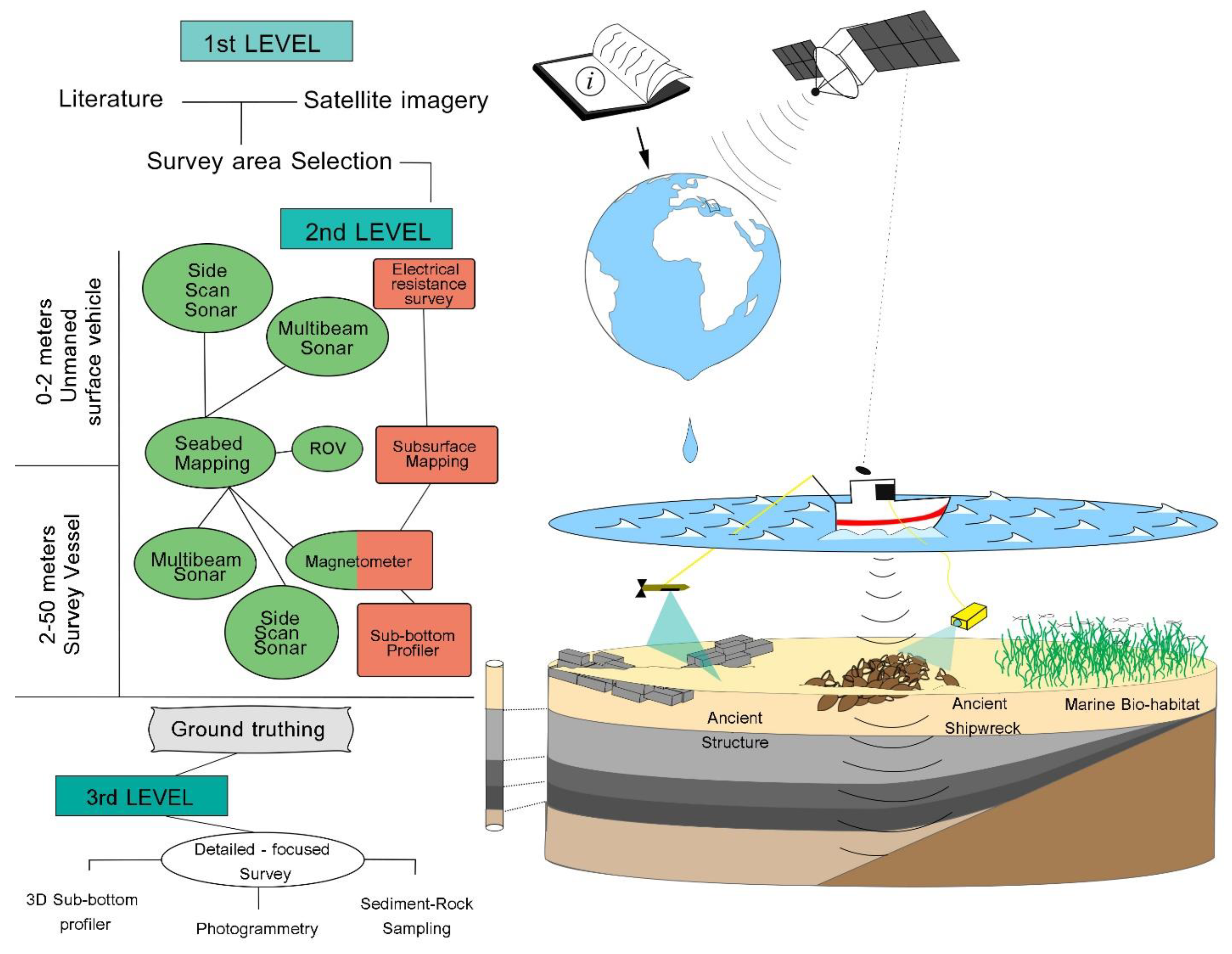
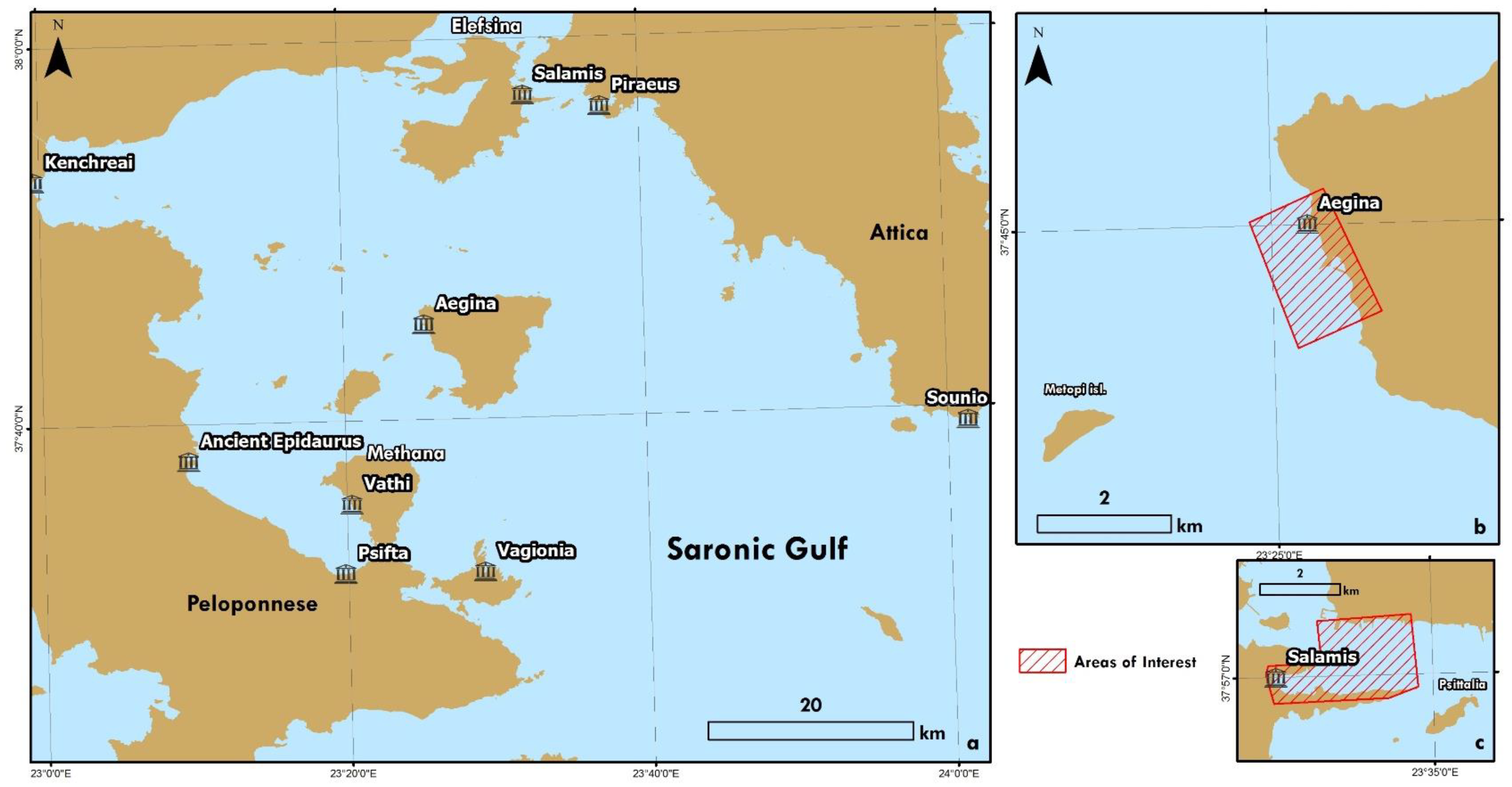
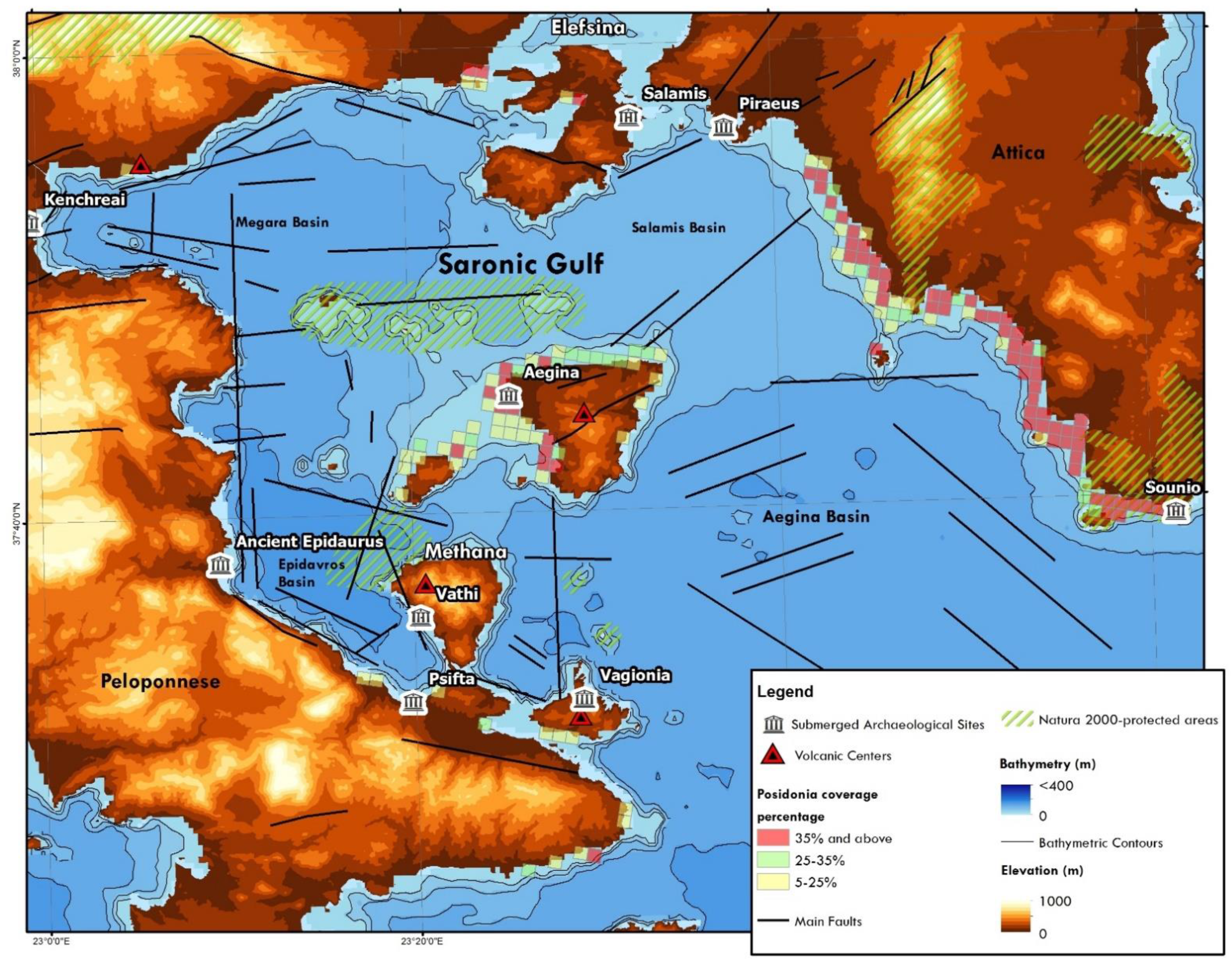

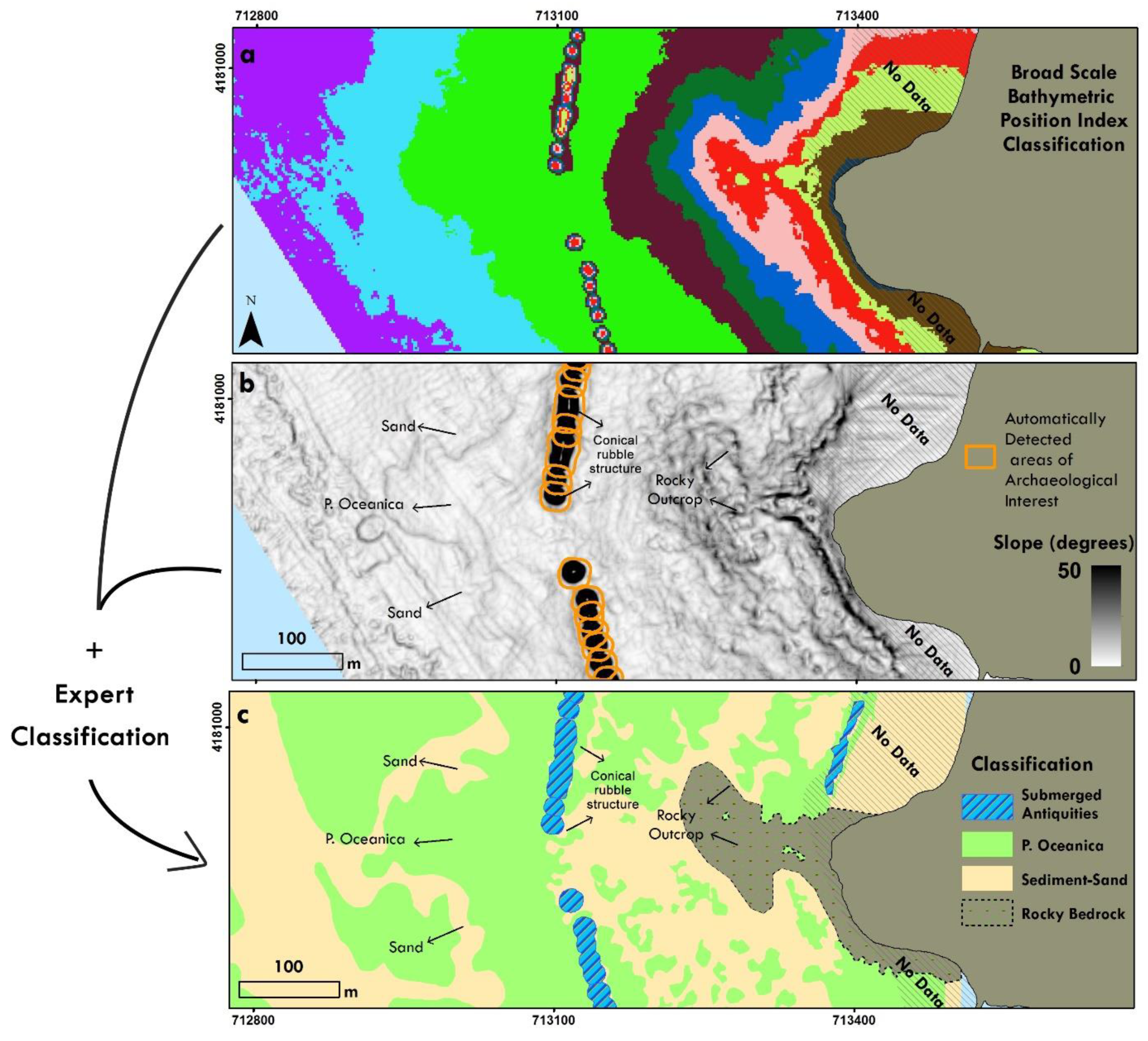
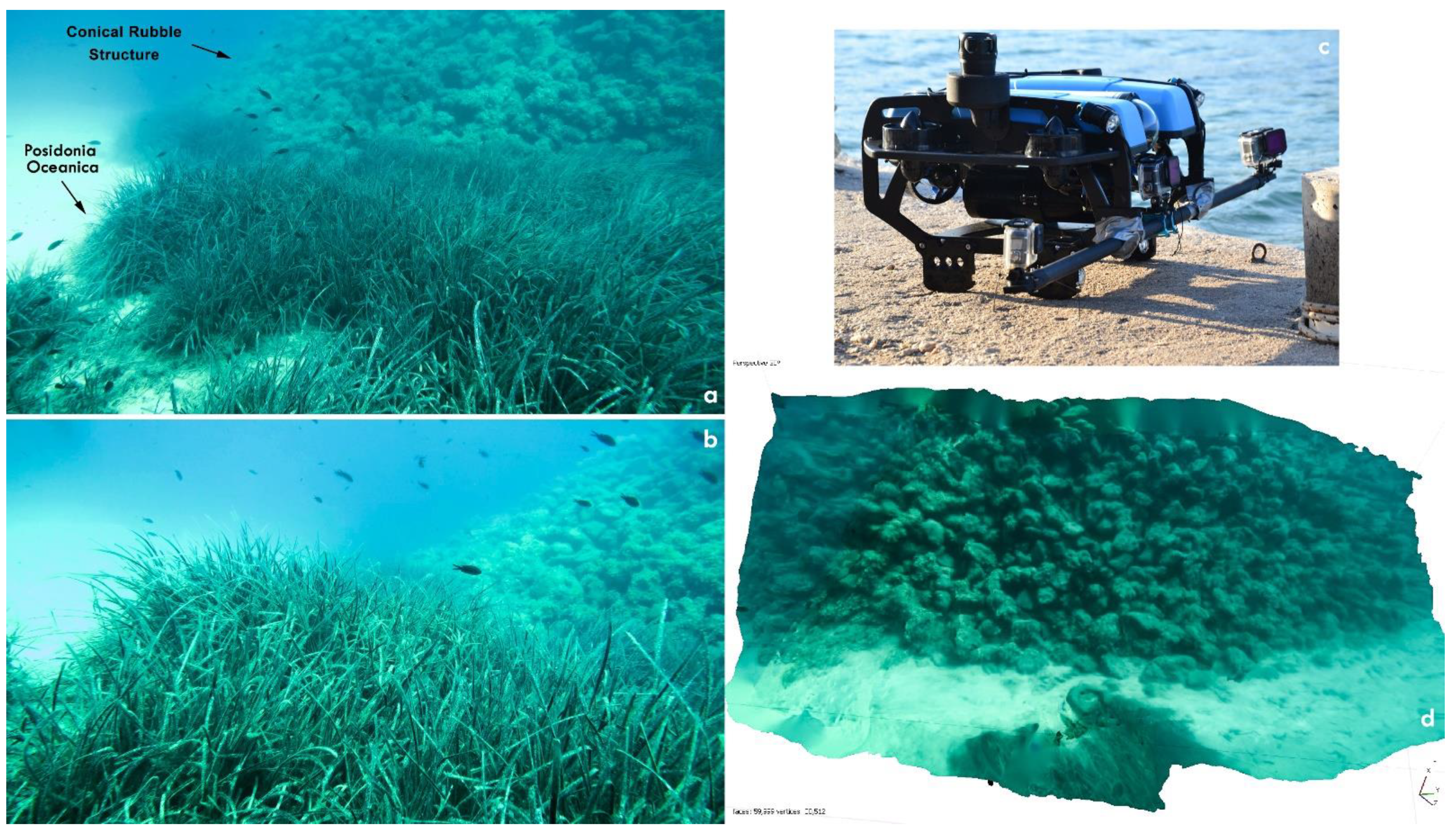

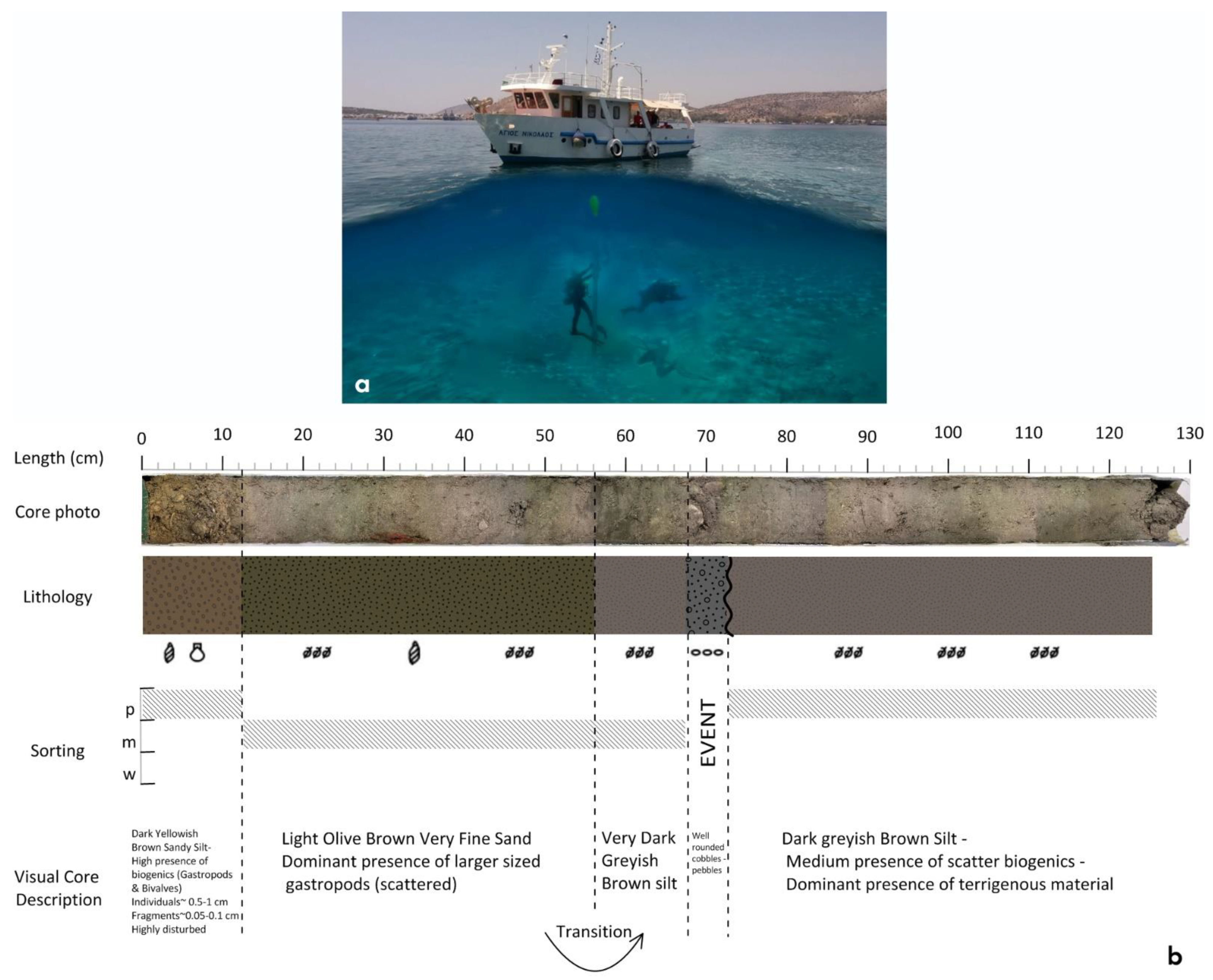

| Information | Source | Resolution | e-link |
|---|---|---|---|
| Satellite Imagery | Google Earth | 15 m | earth.google.com |
| IKONOS Satellite | 4 m multispectral/1 m panchromatic | earth.esa.int | |
| Spot5 Satellite | 10 m multispectral/2,5 m fused | ||
| Sentinel 2 | 10–60 m | sentinel.esa.int | |
| Geomorphology (bathymetry, elevation, sediment thickness etc.) | EMODnet, Copernicus, European Environment Agency, EU Science Hub, GEBCO | 25–500 m | emodnet.ec.europa.eu, www.copernicus.eu (accessed on 5 August 2021), ec.europa.eu, gebco.net |
| Geology, Tectonics | Literature, National Databases | - | - |
| Seabed Habitats, Archaeological Sites | Literature, National Databases | - | - |
| Instrument | Use | Characteristics | Resolution |
|---|---|---|---|
| SSS | Morphology/Target detection | Frequency 100–1000 kHz/Swath 5–200 m | 10 cm |
| MBES | Bathymetry/Morphology | Frequency 300–455 kHz | Depth accuracy~1 cm |
| SBP | Stratigraphy/Target detection | Frequency 1–12 kHz/ | 30 cm (Vertical Res.) |
| Positioning | Vessel positioning and Data Georeference | - | GPS~1 m/DGPS~0.1 m/RTK GPS~0.01 m |
| Instrument | Type | Deployment | Specs | Resolution |
|---|---|---|---|---|
| ITER Systems BathySwath1 | MBES | Over the Side | Depth Range 50 m/ Beams 126/Beam width 1.5°/Frequency 234 kHz | Depth accuracy of ~2 cm |
| Edgetech 4200 SP | SSS | Towed | Frequency 100 and 400 kHz (Simultaneously operated with Chirp Technology)/Swath Range 25–500 m/Depth Rating 2000 m/Beam Width 1.5° @100 kHz and 0.4° @ 400 khz | Across track resolution of 8 cm @100 kHz and 2 cm at 400 kHz |
| Kongsberg GeoPulse Plus | SBP | Over the Side | Transducers 4/Frequency 1.5–18 kHz (Chirp technology)/Pulse Length down 1 mS- Penetration 80 m@ Clay, 6 m @ Coarse Sand | Penetration 80 m @ Clay, 6 m @ Coarse Sand/Vertical down to 6 cm |
Publisher’s Note: MDPI stays neutral with regard to jurisdictional claims in published maps and institutional affiliations. |
© 2021 by the authors. Licensee MDPI, Basel, Switzerland. This article is an open access article distributed under the terms and conditions of the Creative Commons Attribution (CC BY) license (https://creativecommons.org/licenses/by/4.0/).
Share and Cite
Georgiou, N.; Dimas, X.; Papatheodorou, G. Integrated Methodological Approach for the Documentation of Marine Priority Habitats and Submerged Antiquities: Examples from the Saronic Gulf, Greece. Sustainability 2021, 13, 12327. https://doi.org/10.3390/su132112327
Georgiou N, Dimas X, Papatheodorou G. Integrated Methodological Approach for the Documentation of Marine Priority Habitats and Submerged Antiquities: Examples from the Saronic Gulf, Greece. Sustainability. 2021; 13(21):12327. https://doi.org/10.3390/su132112327
Chicago/Turabian StyleGeorgiou, Nikos, Xenophon Dimas, and George Papatheodorou. 2021. "Integrated Methodological Approach for the Documentation of Marine Priority Habitats and Submerged Antiquities: Examples from the Saronic Gulf, Greece" Sustainability 13, no. 21: 12327. https://doi.org/10.3390/su132112327
APA StyleGeorgiou, N., Dimas, X., & Papatheodorou, G. (2021). Integrated Methodological Approach for the Documentation of Marine Priority Habitats and Submerged Antiquities: Examples from the Saronic Gulf, Greece. Sustainability, 13(21), 12327. https://doi.org/10.3390/su132112327








